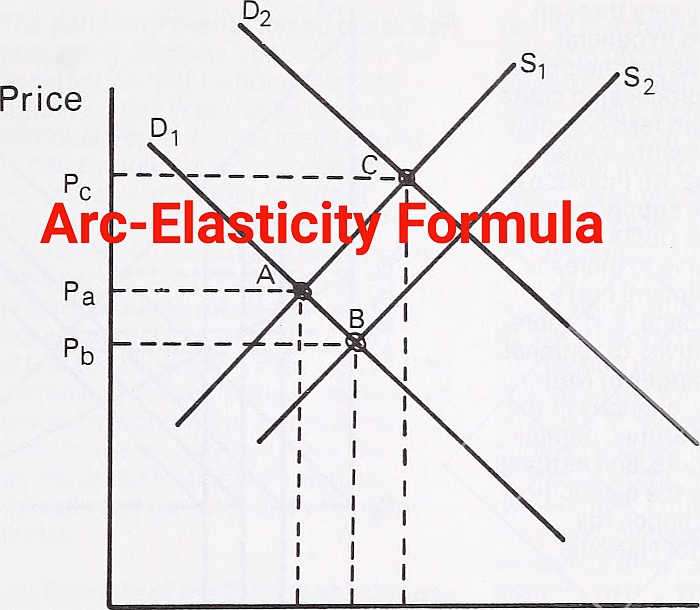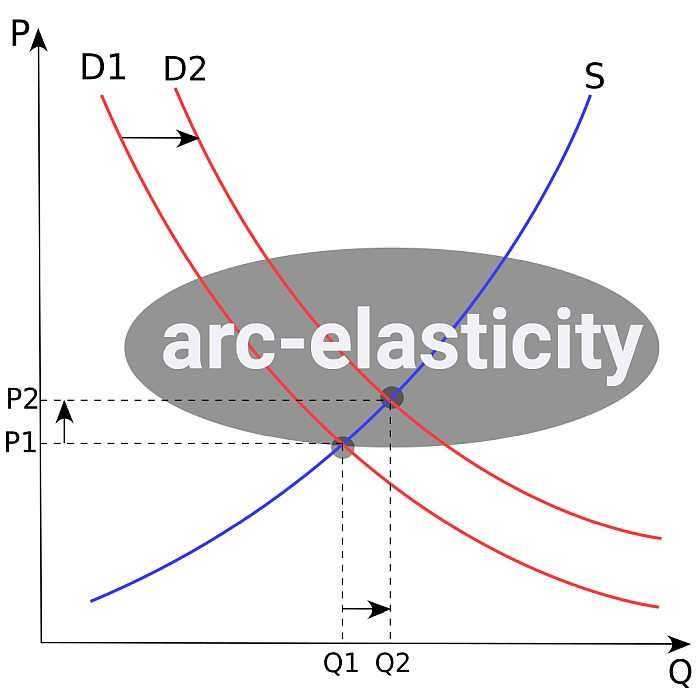About this Arc-Elasticity Calculator
Use this calculator to estimate the price elasticity when you have information about price and demand at two points. This is
for a given \(P_1\), you have a certain quantity demanded \(Q_1\), and then when the price
changes to \(P_2\), the quantity demanded reacts changing to \(Q_2\).
You need to provide valid numeric values for prices and associated quantities demanded. Once that information has been typed in the corresponding boxes,
click on the button that says "Calculate" to see all the steps of the calculation process.
In Economics theory one argues that normal good will see a decrease in the quantity demanded as a response of a price increase.

What you need to understanding about Arc-Elasticity of Demand<
In Economics, elasticity is a numeric measure of the response of demand to changes in price. If price increases by a certain amount, a reaction will be observed in the
quantity demanded, and the relative percent change in quantity demanded versus the relative percent change in price is what we call the price elasticity of demand.
Mathematically speaking, this would be expressed by this formula:
\[ \text{Elasticity} = \displaystyle \frac{\%\Delta Q}{\%\Delta P}\]
We need to know that elasticity is a pointwise, so then taking a small but finite change in price, notated as \(\Delta P\), we are only approximating the value of the
true pointwise elasticity
Using Infinitesimal Price Changes
A better abstraction for this would the use of an infinitesimally small price change, in which case we would get an EXACT expression for the elasticity by
using derivatives, which would be written as
\[ \text{Elasticity} = \displaystyle \frac{dQ}{dP}\frac{P}{Q}\]
In the context of the above formula, \(\frac{dQ}{Q}\) is the infinitesimal percent change in quantity demanded that compared to the infinitesimal percent
change in price, which is \(\frac{dP}{P}\)
Arc-Elasticity Formula
Often times, we don't have access to the actual demand function that would be needed for differentiation purposes, and we only have discrete data. One method to
do a better approximation for the elasticity is using this formula:
\[ \varepsilon_{ARC} = \displaystyle \frac{Q_2 - Q_1}{P_2 - P_1}\frac{P_1 + P_2}{Q_1 + Q_2}\]
which is a simplification of
\[ \varepsilon_{ARC} = \displaystyle \frac{Q_2 - Q1}{P_2 - P_1}\frac{(P_1 + P_2)/}{(Q_1 + Q_2)/2}\]
This indicates that we use an average of the corresponding points to estimate the percent changes in price and quantity demanded.
Steps for using the Arc-Elasticity Formula
- Step 1: Identify the price points P1 and P2, and identity the corresponding quantities demanded as Q1 and Q2, making the correct association of which price
corresponds to which quantity demanded
- Step 2: Once you have P1, P2, Q1 and Q2, use the formula e = (Q2 - Q1)/(P2 - P1)*(P1 + P2)/(Q1 + Q2)
- Step 3: Then, you interpret the elasticity e as the percent change in quantity demanded as a consequence of a 1% change in price
Observe that often times, most of the times, the elasticity is negative, because an increase in price most frequently leads to a decrease in quantity demanded. It is
fine to report the elasticity as a negative number, but be aware that sometimes it is reported in terms of its absolute value.
Practical Applications of Arc-Elasticity of Demand
The elasticity of demand plays a key role in Microeconomics, as it gives a picture of customer sentiment in terms of their sensitivity to price changes. When
firms are operating in a segment of low elasticity values (between -1 and 0), which is called the inelastic range, there is room for price increases and yet
get a relatively moderate reduction in quantity demand, leading to a net increase in revenue.
On the other hand, when firms are operating in a segment of high elasticity values (less than -1), which is called the elastic range, price increases lead to
relatively large reductions in quantity demand, leading to a net decrease in revenue.

Example of Estimating the Arc-Elasticity Formula
A certain good is considered a normal good, and its quantity demanded decreases when price increases. Initially, at a price of
$25, the quantity demanded was 200 units, and when the price was raised to $28, the quantity demanded decreased to 170. Estimate the
price elasticity of demand based on this information.
Solution:We need to compute the arc-elasticity based on the following information provided for two price
points and their corresponding quantities demanded
|
Price 1 \((P_1)\) = |
$\(25\) |
|
Price 2 \((P_2)\) = |
$\(28\) |
|
Quantity Demanded 1 \((Q_1)\) = |
\(200\) |
|
Quantity Demanded 2 \((Q_2)\) = |
\(170\) |
In this case, the arc-elasticity formula need to be used. The formula is:
\[ \varepsilon_{ARC} = \displaystyle \left(\frac{Q_2 - Q1}{P2_P1}\right)\left(\frac{P_1 + P_2}{Q_1 + Q_2}\right)\]
In order to make the calculation, we just need to plug the corresponding values in:
\[ \begin{array}{ccl} \varepsilon_{ARC} & = & \displaystyle \left(\frac{Q_2 - Q_1}{P_2 - P_1} \right)\left(\frac{P_1 + P_2}{Q_1 + Q_2}\right) \\\\ \\\\
& = & \displaystyle \displaystyle \left( \frac{170 - 200}{28 - 25} \right) \left( \frac{25 + 28}{200 + 170} \right) \\\\ \\\\ & = & -1.432 \end{array}\]
The arc-elasticity is in this case \(\varepsilon = -1.432 \), which can be interpreted as follows:
• For an increase of 1% in price, there is an average decrease of 1.432% in quantity demanded, within the price range $25 and $28.
Other elasticity calculators
The calculation of the price elasticity of demand may take different forms. One form is what we do in this calculator, which involves
using the arc-elasticity formula we two points of price and quantity demanded are available
We can take this further with this arc-elasticity table calculator, in which you provide a table of price and quantity demand, and the elasticity is
computed point by point by approximating with arc-elasticity.
In some specific cases you will want to assume constant elasticity, and using this elasticity from sample data calculator, which will yield
useful results only if the price and demand data follow a suitable log-log pattern.
The idea situation is that we have an actual demand function, in which we simply compute the elasticity from the demand function, getting
an exact pointwise estimate of elasticity, unlike the case of arc elasticity which is an approximated value.